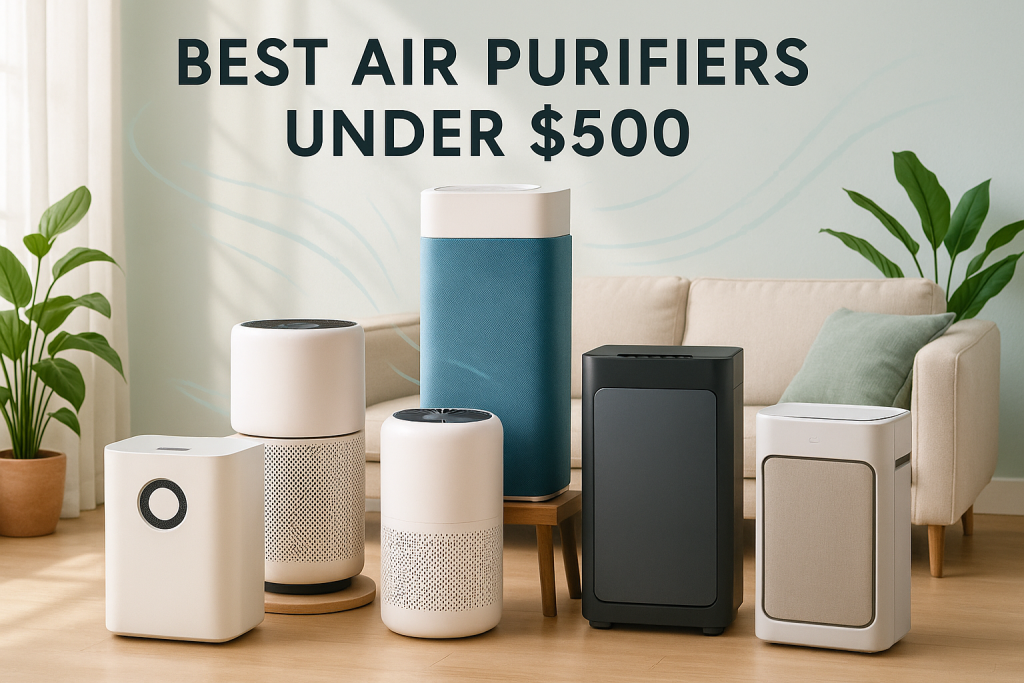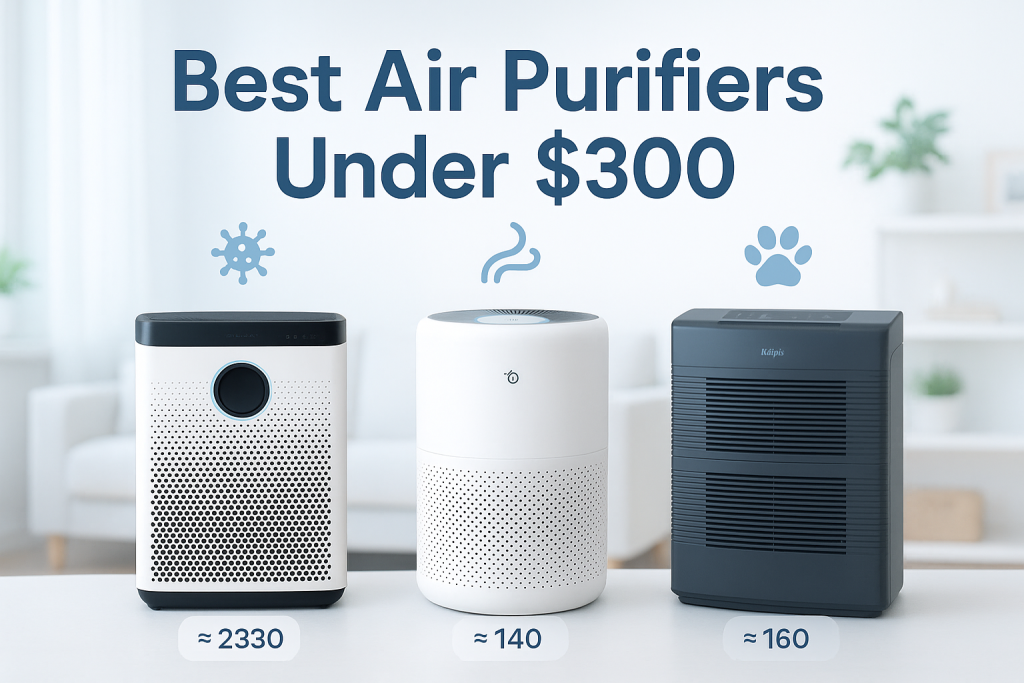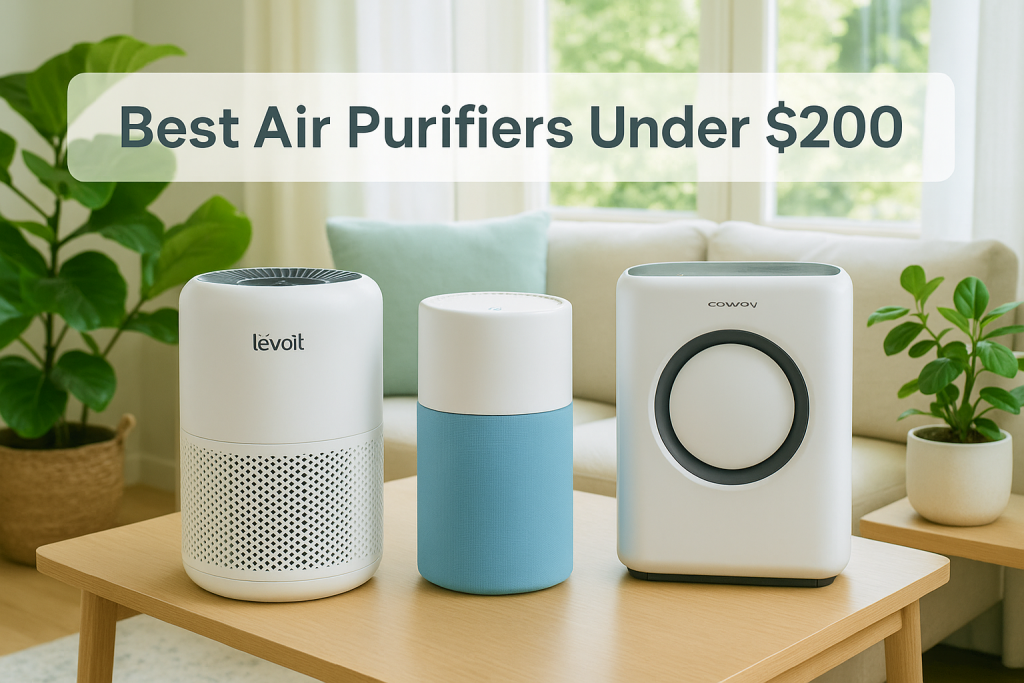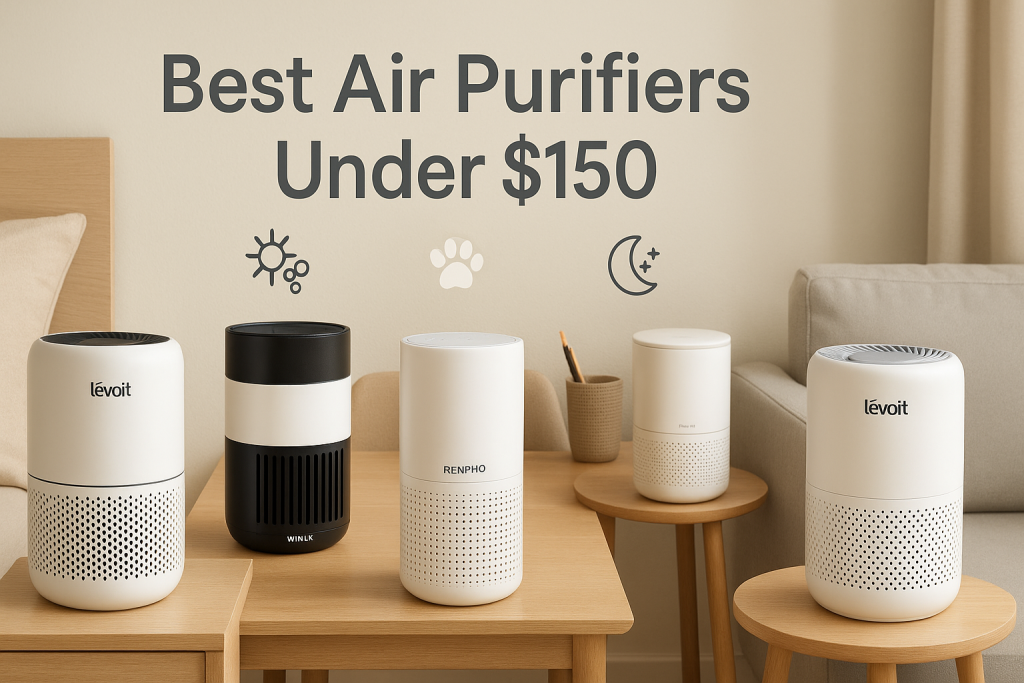Air purifiers have become essential for cabin and cottage owners facing unique air quality challenges. From musty odors and mold to seasonal allergens and wood smoke, cabins require specialized air purification solutions that standard home purifiers might not adequately address. This comprehensive guide will help you navigate the specific needs of cabin environments while providing tailored recommendations for every situation.
For those in a hurry, our top pick for year-round cabins is the Coway Airmega 400, while the Levoit Core 300 offers excellent performance for weekend properties. If you’re dealing with wood smoke, the Austin Air HealthMate Plus excels, and for off-grid situations, consider the portable TruSens Z-1000.
Why Cabins & Cottages Have Unique Air Quality Challenges
Cabin environments present distinct air quality challenges that differ significantly from typical homes. Understanding these unique factors is essential for selecting the right air purifier for your property.
Cabin construction materials significantly impact indoor air quality. Log cabins, while beautiful, can release natural compounds and create air circulation patterns different from conventional homes. Wood preservatives and treatments may also off-gas over time, affecting air quality.
Seasonal use patterns create particular problems. Cabins left unused for weeks or months develop stagnant air, moisture buildup, and musty odors. When reopening a seasonal property, you’re often faced with poor air quality that needs immediate attention.
Rural and wilderness locations expose cabins to higher concentrations of outdoor allergens like pollen, mold spores, and occasionally wildfire smoke particles that contain harmful PM2.5. Without proper filtration, these outdoor pollutants quickly become indoor problems.
Traditional heating methods in cabins, particularly wood stoves and fireplaces, introduce combustion byproducts like smoke particles and gases that can irritate respiratory systems and settle on surfaces throughout the space.
Limited ventilation is common in traditional cabin designs, with fewer windows, smaller HVAC systems, or passive ventilation that doesn’t effectively cycle fresh air, especially during extreme weather when cabins are sealed tight.
Remote locations often mean power limitations, maintenance challenges, and exposure to wilderness elements that urban homes don’t typically face.
Understanding Air Purifier Technologies for Cabin Environments
Before recommending specific models, it’s important to understand which air purification technologies are most effective for cabin-specific challenges.
- HEPA Filtration: The gold standard for particle removal, capturing 99.97% of particles as small as 0.3 microns, including dust, pollen, and most mold spores. Essential for cabin environments.
- Activated Carbon: Critical for cabins to address odors from mustiness, wood smoke, and cooking. Absorbs VOCs, gases, and smells that HEPA filters can’t capture.
- UV-C Light: Beneficial in damp cabins as it kills mold spores, bacteria, and viruses that pass through the system. Not effective against particles or gases.
- Ionizers: Can help with dust and allergens but produce ozone in some models. Use with caution in small cabin spaces.
Understanding CADR (Clean Air Delivery Rate) helps determine appropriate coverage. For cabins, multiply your square footage by 1.5 to account for higher ceilings and open floor plans common in cabin designs.
Energy efficiency becomes crucial in cabins with limited electrical capacity. Look for ENERGY STAR certified models with low wattage ratings (30-90W) for continuous operation without straining power resources.
Filter maintenance deserves special consideration for seasonal properties. Long-lasting filters or models with maintenance indicators help manage upkeep when visits are infrequent.
Top Air Purifiers for Year-Round Cabin Living
For those who use their cabins year-round, these air purifiers offer the durability, filtration effectiveness, and features needed for continuous operation in challenging cabin environments.
Coway Airmega 400
This powerful unit covers up to 1,560 square feet, making it perfect for open-concept cabin layouts. Its dual HEPA and activated carbon filtration effectively handles persistent cabin challenges like wood smoke and seasonal allergens.
- Pros: Quiet operation even on higher settings, energy-efficient, filter life indicator, excellent for large open spaces
- Cons: Higher upfront cost, larger footprint requires dedicated space
- Price Range: $450-550
- Filter Replacement: Every 12 months, approximately $70
Cabin owner James from Colorado reports: “After installing the Airmega in our mountain cabin, the lingering smoke smell from our wood stove disappeared completely. It handles wildfire season remarkably well too.”
Austin Air HealthMate
Built like a tank with an all-steel construction, this purifier excels in demanding cabin environments. Its 15-pound activated carbon and zeolite filter makes it exceptionally effective against odors from dampness, cooking, and wood burning.
- Pros: Medical-grade filtration, 5-year filter life, exceptional durability, excellent for smoke removal
- Cons: Heavier unit (45 lbs), limited smart features
- Price Range: $595-715
- Filter Replacement: Every 5 years, approximately $345
The HealthMate’s long filter life makes it particularly valuable for cabin owners who want minimal maintenance concerns.
Blueair Blue Pure 211+
This Swedish-designed purifier balances performance, aesthetics, and ease of use. Its washable pre-filter comes in different colors to match cabin décor while handling large spaces up to 650 square feet.
- Pros: Simple one-button operation, quiet, energy-efficient, stylish design
- Cons: No auto mode, lacks smart features
- Price Range: $299-340
- Filter Replacement: Every 6 months, approximately $70
The 211+ is particularly popular in waterfront cabins where boats may be docked nearby, as it handles both indoor and outdoor pollution sources effectively.
Best Air Purifiers for Seasonal and Weekend Cabins
Weekend and seasonal cabin users face different challenges, including extended periods without use and the need for rapid air quality improvement upon arrival. These purifiers excel in such environments.
Levoit Core 300
This compact but powerful purifier is ideal for weekend cabins, cleaning the air in spaces up to 219 square feet in just 12 minutes. Its portability makes it perfect for bringing along on trips to your getaway.
- Pros: Highly portable, quiet operation, quick air cleaning, affordable
- Cons: Smaller coverage area, needs more frequent filter changes with heavy use
- Price Range: $99-110
- Filter Replacement: Every 6-8 months, approximately $30
Users particularly praise its ability to eliminate musty odors within hours of arriving at a cabin that’s been closed up.
Winix 5500-2
With its combination of True HEPA filtration, carbon filter, and PlasmaWave technology, this mid-sized unit quickly addresses stale air and odors in seasonal properties up to 360 square feet.
- Pros: Auto mode adjusts to air quality, sleep mode for quiet operation, washable pre-filter
- Cons: PlasmaWave cannot be disabled on some models
- Price Range: $159-180
- Filter Replacement: HEPA every 12 months ($70), carbon every 3 months ($20)
The auto mode is particularly valuable for seasonal cabins, as it ramps up automatically when detecting poor air quality upon reopening the property.
TruSens Z-2000
This innovative purifier features a separate SensorPod that can be placed across the room to detect air quality issues throughout the space, making it excellent for cabins with varying air quality zones.
- Pros: Remote air quality sensing, 360-degree filtration, UV sterilization, handle for portability
- Cons: SensorPod requires separate power
- Price Range: $229-250
- Filter Replacement: HEPA/Carbon every 12-15 months ($50), pre-filter every 3 months ($15)
The carry handle and moderate weight make this a good option for transporting between your primary residence and weekend cabin.
Specialized Air Purifiers for Cabins with Wood-Burning Stoves & Fireplaces
Wood-burning stoves and fireplaces create specific air quality challenges in cabins. These specialized purifiers effectively address wood smoke particles and related air quality issues.
Austin Air HealthMate Plus
Specifically designed for smoke and chemical sensitivity, this model excels in cabins with active wood-burning heat sources. Its enhanced carbon blend captures the volatile organic compounds found in wood smoke.
- Pros: Superior smoke particle filtration, removes chemicals and VOCs, 5-year filter life
- Cons: Higher price point, larger size
- Price Range: $715-845
- Filter Replacement: Every 5 years, approximately $395
For effective use, place the HealthMate Plus at least 10 feet from the wood stove but in the same room to capture smoke particles as they disperse.
Blueair Blue Pure 211+ Auto
The updated Auto version of the 211+ includes particle sensors that detect smoke particles and automatically adjust filtration levels. This responsiveness makes it excellent for spaces with intermittent wood burning.
- Pros: Responsive auto mode, effective against smoke particles, washable pre-filter captures larger ash
- Cons: Carbon filter layer could be more substantial for heavy smoke
- Price Range: $339-380
- Filter Replacement: Every 6-8 months, approximately $80
Users with wood stoves report best results when replacing filters more frequently during the heating season.
Off-Grid & Energy-Efficient Air Purification Solutions for Remote Cabins
Limited or inconsistent electricity supply presents unique challenges for cabin air purification. These innovative solutions provide effective air cleaning with minimal energy requirements.
TruSens Z-1000
With energy consumption as low as 5W on its lowest setting, this compact purifier can run on small solar setups or limited generator power while still providing effective filtration for spaces up to 250 square feet.
- Pros: Very low power consumption, lightweight, simple operation
- Cons: Smaller coverage area, no auto features
- Price Range: $139-160
- Filter Replacement: Every 12-15 months, approximately $35
When paired with a 100W solar panel and battery storage, this unit can provide continuous filtration without grid power.
IQAir Atem Desk
This ultra-efficient personal air purifier uses only 1.5W of power while providing hospital-grade filtration in your immediate breathing zone, making it perfect for sleeping areas in off-grid cabins.
- Pros: Extremely low power consumption, USB power option, ultra-quiet operation
- Cons: Limited coverage to personal space only
- Price Range: $399-450
- Filter Replacement: Every 12 months, approximately $79
Its USB power option allows connection to portable power banks or small solar chargers for true off-grid operation.
Non-Electric Alternatives
For cabins with extremely limited power, consider these non-electric options:
- Beeswax Candles: Naturally release negative ions that help remove airborne particles
- Activated Charcoal Bags: Absorb odors and some toxins passively
- Salt Lamps: May help reduce airborne irritants through hygroscopic action
While less effective than powered purifiers, these can supplement air quality between visits or during power limitations.
Compact Air Purifiers for Small Cabins, Lofts & Limited Spaces
Many cabins and cottages offer limited square footage, making efficient use of space essential. These compact yet powerful purifiers deliver excellent performance without consuming valuable floor space.
Levoit Core 200S
At just 8.7 inches in diameter and 12.6 inches tall, this compact unit fits on nightstands or small shelves while effectively cleaning the air in spaces up to 183 square feet.
- Pros: Very small footprint, quiet operation (24dB), smart control via app
- Cons: Smaller coverage area, more frequent filter replacements
- Price Range: $89-110
- Filter Replacement: Every 6-8 months, approximately $30
Its cylindrical design makes it easy to place in corners or tight spaces in compact cabin layouts.
Blueair Blue Pure 411 Auto
This tiny powerhouse stands just 16.7 inches tall with a 7.9-inch diameter, yet effectively cleans the air in spaces up to 190 square feet. Its auto mode adjusts to air quality without requiring manual control.
- Pros: Ultra-compact size, energy efficient (1.5-10W), washable pre-filter
- Cons: Limited to small spaces, basic controls
- Price Range: $139-160
- Filter Replacement: Every 6 months, approximately $45
The 411 Auto works well in cabin lofts and sleeping areas where space is at a premium but air quality is crucial for comfort.
Air Purifiers for Damp Cabins & High-Humidity Environments
Cabins in lakeside, coastal, or heavily wooded locations often face significant humidity challenges that contribute to mold and mildew. These specialized purifiers address both air quality and moisture concerns.
Frigidaire FAPD01 Air Purifier & Dehumidifier
This combination unit pulls double duty by capturing airborne particles while removing up to 35 pints of moisture daily, making it ideal for damp cabins near water.
- Pros: Two functions in one unit, covers 600 sq ft, continuous drain option
- Cons: Larger size, higher energy consumption
- Price Range: $329-400
- Filter Replacement: HEPA filter every 6 months ($30)
For optimal results in high-humidity environments, maintain indoor humidity between 30-50% to prevent mold growth while ensuring comfort.
Winix AM90
With its true HEPA filtration plus advanced antimicrobial treatment, this model specifically targets mold spores and allergens common in damp environments. Its washable pre-filter captures larger mold particles before they reach the main filter.
- Pros: Antimicrobial protection, effective against mold spores, smart control via app
- Cons: Requires separate dehumidifier for moisture control
- Price Range: $220-260
- Filter Replacement: HEPA/carbon every 12 months ($60)
Users in lakeside cabins report significant reduction in musty odors and improved air quality, particularly when used in conjunction with a dehumidifier.
Wildfire Protection: Air Purifiers for Wilderness Cabins in Fire-Prone Areas
Cabins in wilderness areas increasingly face wildfire smoke exposure. Proper air purification becomes essential for maintaining safe indoor air quality during fire season.
IQAir HealthPro Plus
This Swiss-engineered purifier is widely considered the gold standard for smoke removal, capturing 99.97% of particles down to 0.3 microns and 95% of particles as small as 0.003 microns—the ultrafine particles that make wildfire smoke particularly dangerous.
- Pros: Medical-grade filtration, 1,125 sq ft coverage, long filter life
- Cons: Premium price point, larger size, heavier weight
- Price Range: $899-1,000
- Filter Replacement: Pre-filter every 6-18 months ($80), HEPA every 2-4 years ($200), carbon every 2 years ($100)
The U.S. Forest Service and environmental agencies recommend HyperHEPA filtration like IQAir’s for serious wildfire smoke protection.
Coway Airmega 250S
With real-time air quality monitoring and app control, this unit allows you to check cabin air quality remotely and activate the purifier before arrival during fire season. Its 3-stage filtration effectively removes smoke particles.
- Pros: Remote monitoring via app, auto mode responds to smoke, 930 sq ft coverage
- Cons: Requires Wi-Fi connectivity
- Price Range: $399-449
- Filter Replacement: Every 12 months, approximately $70
During heavy smoke conditions, expect to replace filters 2-3 times more frequently for optimal performance.
Durable, Low-Maintenance Air Purifiers for Vacation Rental Cabins
Vacation rental cabin owners face unique challenges: balancing effectiveness with durability, guest-friendliness, and minimal maintenance requirements between visitors.
Rabbit Air MinusA2
Designed with simplicity and durability in mind, this wall-mountable purifier saves floor space while providing sophisticated filtration that requires minimal guest interaction.
- Pros: Wall-mountable design, customizable front panels, 6-stage filtration, quiet operation
- Cons: Premium price point, complex filter replacement
- Price Range: $550-620
- Filter Replacement: Every 12 months, approximately $85
Rental property managers report that the artistic front panels become a talking point for guests while the quiet operation ensures no complaints about noise.
Honeywell HPA300
This workhorse purifier combines institutional durability with simple controls that any guest can operate without confusion. Its robust construction withstands frequent handling.
- Pros: Simple interface, durable construction, high CADR ratings, affordable replacement filters
- Cons: Utilitarian appearance, somewhat louder operation
- Price Range: $249-300
- Filter Replacement: Carbon pre-filter every 3 months ($10), HEPA every 12 months ($70)
Many vacation rental owners highlight this model in their listings as an amenity, noting improved reviews and fewer complaints about cabin odors or allergies.
Optimal Placement & Setup Guide for Cabin Air Purifiers
Even the best air purifier won’t perform effectively if improperly placed. Cabin layouts present unique placement challenges that require specific solutions.
Main Living Area Placement
In open-concept cabins, position your primary purifier in the central living space, at least 3 feet from walls and furniture. For cabins with wood stoves, place the purifier at least 6-10 feet from the stove but within the same room to capture smoke particles.
Bedroom and Loft Placement
In sleeping areas, position smaller units at least 2 feet above the floor (to capture settled allergens) and within 6-8 feet of beds. For lofts, place the purifier near the top of the stairs where air naturally circulates between levels.
Multi-Level Considerations
Cabins with multiple levels require strategic placement. Since air typically rises, place your primary unit on the lower level and secondary units in upper areas. Consider airflow patterns created by stairs, vents, and ceiling fans.
Common Placement Mistakes
- Placing units directly against walls or in corners (reduces air intake)
- Positioning too close to moisture sources like bathrooms or kitchen cooking areas that produce steam and grease
- Placing near heating vents where hot air reduces efficiency
- Blocking intake or output vents with furniture or curtains
Seasonal Maintenance Calendar for Cabin Air Purifiers
Cabin air purifiers require specialized maintenance schedules that differ from regular home use, especially with seasonal or intermittent occupancy patterns.
Spring Opening Procedures
- Replace all filters before the season starts
- Clean external surfaces with damp cloth
- Run on highest setting for 2-3 hours upon arrival
- Check for proper operation and error codes
Summer Maintenance
- Clean pre-filters monthly during heavy use periods
- Check filter indicators before each visit
- Vacuum dust from external vents and intakes
- Position away from air conditioning vents
Fall Preparation
- Replace filters before heating season begins
- Clean all surfaces thoroughly
- Check for debris from summer use
- Consider upgrading carbon filters if wood heat will be used
Winter/Off-Season Storage
- Run unit on high for 2-3 hours before closing cabin
- Remove and discard old filters
- Cover unit with breathable material (not plastic)
- Store in dry location if cabin experiences extreme cold
- For extended vacancy, consider removing and storing in climate-controlled space
Cabin Air Purifier Comparison Chart: Finding Your Perfect Match
This comprehensive comparison chart consolidates all recommended models across cabin-specific categories to help you identify the perfect match for your unique property needs.
| Model | Best For | Coverage | Filter Types | Replacement Cost | Energy Use | Special Features |
|---|---|---|---|---|---|---|
| Coway Airmega 400 | Year-round, large cabins | 1,560 sq ft | True HEPA, Carbon | $70/year | 66W max | Air quality indicator, Auto mode |
| Austin Air HealthMate | Year-round, wood heat | 1,500 sq ft | Medical HEPA, Carbon/Zeolite | $345/5 years | 135W max | 5-year filter, Made in USA |
| Levoit Core 300 | Weekend cabins, portable | 219 sq ft | H13 HEPA, Carbon | $30/6-8 months | 45W max | Ultra-quiet, compact |
| IQAir HealthPro Plus | Wildfire-prone areas | 1,125 sq ft | HyperHEPA, V5-Cell Carbon | $380/2-4 years | 215W max | Medical-grade, 0.003 micron filtration |
| TruSens Z-1000 | Off-grid, energy-efficient | 250 sq ft | HEPA, Carbon, UV | $35/year | 5-40W | Low power consumption |
| Frigidaire FAPD01 | Damp cabins, high humidity | 600 sq ft | HEPA, dehumidifier | $30/6 months | 80-640W | Dual function, 35 pint dehumidifier |
Frequently Asked Questions About Air Purifiers for Cabins & Cottages
How much power do air purifiers use in off-grid cabins?
Energy-efficient models like the TruSens Z-1000 use as little as 5W on low settings, making them compatible with small solar setups. For reference, a 100W solar panel with battery storage can run a small air purifier continuously. Ultra-efficient models like the IQAir Atem use only 1.5W and can run on USB power banks.
How effective are air purifiers against cabin musty odors?
Purifiers with substantial activated carbon filters can eliminate musty odors within 24-48 hours of operation. For best results, choose models with at least 5-10 pounds of carbon filtration like the Austin Air HealthMate for persistent odors, or run multiple smaller units simultaneously when reopening a seasonal property.
Do I need different air purifier settings for winter versus summer use?
Yes. During winter when cabins are sealed tight and wood heat is used, run purifiers on higher settings with more frequent filter replacements. In summer, when doors and windows are often open, focus on keeping pre-filters clean to capture larger particles and pollen. Models with humidity sensors work differently across seasons as indoor humidity levels change.
How should I store my air purifier between cabin visits?
For seasonal properties, run the purifier on high for several hours before departure to clean the air, then remove and discard filters to prevent mold growth within the unit. Cover with a breathable cloth (not plastic) and store in a dry location within the cabin. For extended storage, consider bringing the unit to your primary residence, especially if the cabin experiences freezing temperatures.
What’s the best solution for a cabin with a damp basement or crawlspace?
For cabins with below-grade spaces that contribute to moisture and air quality issues, use a combination approach: place a dehumidifier in the basement/crawlspace itself, use a purifier with both HEPA and substantial carbon filtration on the main floor, and consider a crawlspace vapor barrier installation to reduce moisture migration.
How do different cabin construction types affect air purifier selection?
Log cabins typically have higher levels of natural VOCs from wood resins and more air infiltration, requiring strong carbon filtration. Modern tight-construction cabins need purifiers that address trapped indoor pollutants. Stone or masonry cabins often have higher humidity and require models with better mold-fighting capabilities. A-frames and cabins with cathedral ceilings need higher-capacity units due to larger air volumes.
Can I use a car air purifier in a small cabin when electrical capacity is limited?
Vehicle air purifiers can work for very small cabins (under 150 sq ft) or individual rooms when plugged into 12V power sources. They’re particularly useful in off-grid situations with limited electricity, but their small filters require frequent replacement when used in larger spaces than vehicles.
Conclusion: Investing in Cleaner Air for Your Cabin Retreat
A quality air purifier specifically suited to your cabin’s unique environment can transform your retreat experience while protecting both your health and property investment. By selecting a model that addresses your specific challenges—whether that’s wood smoke, seasonal dampness, wildfire concerns, or off-grid limitations—you’ll create a healthier, more comfortable space that enhances your enjoyment of cabin life.
The best approach often combines strategies: a primary purifier for main living areas, smaller units for bedrooms, and complementary solutions like dehumidifiers for moisture control. Regular maintenance tailored to your usage pattern ensures optimal performance and longevity.
As environmental challenges like wildfires become more common and awareness of indoor air quality grows, purification technology continues to advance. Today’s models offer unprecedented effectiveness while addressing cabin-specific concerns like power efficiency, durability, and specialized filtration for rural environments.
By making an informed choice based on your cabin’s particular needs, you’re not just purchasing an appliance—you’re investing in healthier, more enjoyable experiences in your special retreat space for years to come.
When selecting your cabin air purifier, focus first on your most pressing air quality challenges, then consider practical factors like power requirements, maintenance needs, and coverage capacity for your specific space. The right purifier shouldn’t just clean your air—it should seamlessly integrate into your cabin lifestyle while protecting what matters most.
| Photo | Air Purifier Model | Best for | Price |
|---|---|---|---|

|
WINIX A231 Air Purifier | Asthma & Indoor Pollution | Check Price On Amazon |

|
Rabbit Air, A3 SPA-1000N Air Purifier | Pet Dander & Odors | Check Price On Amazon |

|
LEVOIT Air Purifier | Best Overall | Check Price On Amazon |

|
GermGuardian Air Purifier | Cigarette & Cooking Smoke | Check Price On Amazon |

|
Coway Airmega Air Purifier | New-borns | Check Price On Amazon |

|
BLUEAIR Air Purifier | Germ & Virus Control | Check Price On Amazon |






